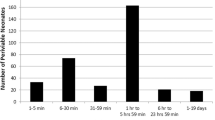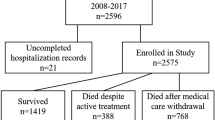Abstract
Objective
We aimed to identify differences in morbidity and mortality between inborn versus outborn extremely low birth weight (ELBW) infants admitted to the Texas Children’s Hospital neonatal intensive care unit (NICU).
Study design
Vermont Oxford Network data were analyzed between January 2014 and December 2017. Inborn versus outborn outcomes were compared.
Result
Of 533 ELBW infants, 402 were inborn, and 131 were outborn. Gestational age and birth weight (BW) were similar. After adjusting outcomes to control for maternal steroids, maternal hypertension, maternal prenatal care, and temperature below 36 °C at admission, no outcomes were significantly different except inborn patients had decreased odds of late onset sepsis (adjusted odds ratio = 0.606, 95% confidence interval: 0.377–0.973, p = 0.038).
Conclusion
In this study, outborn ELBW patients had increased odds of late onset sepsis compared with inborn ELBW patients after controlling for covariates that differed significantly between these two cohorts.
This is a preview of subscription content, access via your institution
Access options
Subscribe to this journal
Receive 12 print issues and online access
$259.00 per year
only $21.58 per issue
Buy this article
- Purchase on Springer Link
- Instant access to full article PDF
Prices may be subject to local taxes which are calculated during checkout
Similar content being viewed by others
References
Lawn JE, Blencowe H, Oza S, You D, Lee AC, Waiswa P, et al. Every newborn: progress, priorities, and potential beyond survival. Lancet. 2014;384:189–205. PubMed PMID: 24853593.
GHO. World Health Statistics data visualizations dashboard. Neonatal mortality. http://apps.who.int/gho/data/node.sdg.3-2-viz-3?lang=en. Accessed 4 Nov 2019.
Lau C, Ambalavanan N, Chakraborty H, Wingate MS, Carlo WA. Extremely low birth weight and infant mortality rates in the United States. Pediatrics. 2013;131:855–60. PubMed PMID: 23545381.
Shaffer ER. State policies and regional neonatal care: progress and challenges 25 years after TIOP. White Plains, NY: March of Dimes; 2001.
Abraham MR, Ashton DM, Badura M, Barfield WD, Beck CT, Berghella V, et al. Toward improving the outcome of pregnancy III. 1275 Mamaroneck Avenue White Plains, NY: March of Dimes; 2010. https://www.marchofdimes.org/toward-improving-the-outcome-of-pregnancy-iii.pdf.
Phibbs CS, Bronstein JM, Buxton E, Phibbs RH. The effects of patient volume and level of care at the hospital of birth on neonatal mortality. JAMA. 1996;276:1054–9. PubMed PMID: 8847767.
Yeast JD, Poskin M, Stockbauer JW, Shaffer S. Changing patterns in regionalization of perinatal care and the impact on neonatal mortality. Am J Obstet Gynecol. 1998;178(1 Pt 1):131–5. PubMed PMID: 9465816.
Goodman DC, Fisher ES, Little GA, Stukel TA, Chang CH, Schoendorf KS. The relation between the availability of neonatal intensive care and neonatal mortality. New Engl J Med. 2002;346:1538–44. PubMed PMID: 12015393.
Holmstrom ST, Phibbs CS. Regionalization and mortality in neonatal intensive care. Pediatr Clin North Am. 2009;56:617–30. Table of Contents. PubMed PMID: 19501695.
Phibbs CS, Baker LC, Caughey AB, Danielsen B, Schmitt SK, Phibbs RH. Level and volume of neonatal intensive care and mortality in very-low-birth-weight infants. New Engl J Med. 2007;356:2165–75. PubMed PMID: 17522400.
Lasswell SM, Barfield WD, Rochat RW, Blackmon L. Perinatal regionalization for very low-birth-weight and very preterm infants: a meta-analysis. JAMA. 2010;304:992–1000. PubMed PMID: 20810377.
Lorch SA, Baiocchi M, Ahlberg CE, Small DS. The differential impact of delivery hospital on the outcomes of premature infants. Pediatrics. 2012;130:270–8. PubMed PMID: 22778301. Pubmed Central PMCID: 4074612.
American Academy of Pediatrics Committee on F, Newborn. Levels of neonatal care. Pediatrics. 2012;130:587–97. PubMed PMID: 22926177.
Hamilton BE, Martin JA, Osterman MJ, Curtin SC, Matthews TJ. Births: final data for 2014. Natl Vital Stat Rep. 2015;64:1–64. PubMed PMID: 26727629.
Mandell DJ, Kormondy M. Healthy Texas babies: data book. Austin, Texas: Texas Department of State Health Services, Services DfFaCH; 2015.
Riley LE, Stark A. Guidelines for perinatal care. 7 ed. American Academy of Pediatrics and American College of Obstetrics and Gynecology; 2014. http://simponline.it/wp-content/uploads/2014/11/GuidelinesforPerinatalCare.pdf.
Texas State Legislature House Bill 15, Legislative Session 83, (2013).
Neonatal System Development. Texas Department of State Health Services: Texas Health and Human Services. https://www.dshs.texas.gov/emstraumasystems/neonatal.aspx. Accessed 4 Nov 2019.
Amer R, Moddemann D, Seshia M, Alvaro R, Synnes A, Lee KS, et al. Neurodevelopmental outcomes of infants born at <29 weeks of gestation admitted to Canadian neonatal intensive care units based on location of birth. J Pediatr. 2018;196:31–7 e1. PubMed PMID: 29305231.
Boland RA, Davis PG, Dawson JA, Doyle LW. Outcomes of infants born at 22–27 weeks’ gestation in Victoria according to outborn/inborn birth status. Arch Dis Child Fetal Neonatal Ed. 2017;102:F153–F61. PubMed PMID: 27531224.
Hossain S, Shah PS, Ye XY, Darlow BA, Lee SK, Lui K, et al. Outborns or inborns: where are the differences? a comparison study of very preterm neonatal intensive care unit infants cared for in Australia and New Zealand and in Canada. Neonatology. 2016;109:76–84. PubMed PMID: 26583768.
Mahoney K, Bajuk B, Oei J, Lui K, Abdel-Latif ME, Network N. Risk of neurodevelopmental impairment for outborn extremely preterm infants in an Australian regional network. J Matern Fetal Neonatal Med. 2017;30:96–102. PubMed PMID: 26957041.
Neontal Intensive Care Unit: About us Houston. Texas: Texas Children’s Hospital; 2017. https://www.texaschildrens.org/departments/neonatal-intensive-care-unit.
Bolisetty S, Dhawan A, Abdel-Latif M, Bajuk B, Stack J, Lui K, et al. Intraventricular hemorrhage and neurodevelopmental outcomes in extreme preterm infants. Pediatrics. 2014;133:55–62. PubMed PMID: 24379238.
Garland JS. Strategies to prevent ventilator-associated pneumonia in neonates. Clin Perinatol. 2010;37:629–43. PubMed PMID: 20813275.
Steiner M, Langgartner M, Cardona F, Waldhor T, Schwindt J, Haiden N, et al. Significant reduction of catheter-associated blood stream infections in preterm neonates after implementation of a care bundle focusing on simulation training of central line insertion. Pediatr Infect Dis J. 2015;34:1193–6. PubMed PMID: 26186105.
Author information
Authors and Affiliations
Corresponding author
Ethics declarations
Conflict of interest
The authors declare that they have no conflict of interest.
Additional information
Publisher’s note Springer Nature remains neutral with regard to jurisdictional claims in published maps and institutional affiliations.
Rights and permissions
About this article
Cite this article
Brasher, M.I., Patil, M., Hagan, J. et al. Mortality and morbidity in outborn extremely low birth weight neonates: a retrospective analysis. J Perinatol 40, 337–343 (2020). https://doi.org/10.1038/s41372-019-0543-2
Received:
Revised:
Accepted:
Published:
Issue Date:
DOI: https://doi.org/10.1038/s41372-019-0543-2
This article is cited by
-
Why so little progress in regionalization of perinatal care when transport of high-risk neonates remains a substantial risk?
Journal of Perinatology (2020)



